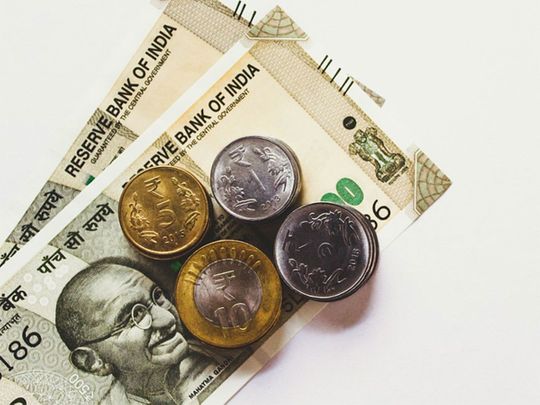
Dubai: The Indian rupee has finally shot past the psychologically important level of 75 to the dollar. It was in August of 2018 that the currency had breached the 70 mark for the first time.
With investors piling into the dollar, the rupee’s weakness could accelerate. Right now, it is trading at 75.12 and well over the previous all-time high of 74.50.
On a dirham to rupee basis, one dirham is now at 20.46. According to sources at local currency houses, most of the remittances to India from the UAE this month had already taken place in the first seven to 10 days, when the dirham was at around 20.22 levels. “I don’t think too many resident Indians were holding back for the rupee to decline further, at least the salaried ones,” said a currency house official.
A fact repeated by Antony Jos, Executive Director at Joyalukkas Exchange: “Generally, mid-month remittance numbers are low. But even then, volumes in the last two days were on the higher side.
“It could be that the rupee could keep falling until the end of this month, which could be when the Reserve Bank of India might take measures to control.”

It could be that the rupee could keep falling until the end of this month
Remittance spikes
According to Rashed Al Ansari, CEO of Al Ansari Exchange, remittances to India has increased by more than 10-15 per cent since the rupee started showing weakness all over again.
"The rupee has breached 75 to the dollar - a level it had never reached; 73 to the dollar was the second highest peak in the past 15 years and took place in October 2019.
"Many other currencies have dropped against the dirham as well, such as the euro, the pound and the Canadian dollar due to the current global market situation. The global market upheaval will dictate the next move.
"For the moment, it’s still difficult to tell whether this will be the new level the rupee settles at or whether this will strengthen or weaken."

For the moment, it’s still difficult to tell whether this will be the new level of the rupee
What’s the central bank doing?
Market watchers have been talking about the Indian central bank stepping to halt the decline... and it did make some interventions tapping into its $470 billion plus of reserves. But clearly, the Reserve Bank of India needs to do so more forcefully to stem the fall.
According to Siddarth Razdan of Indianivesh, which manages a fund, “Dollar liquidity is drying up and India’s exports will be affected. Even remittances will suffer due to the prevailing global economic situation (which could lead to job losses for expats).
“The Reserve Bank of India has been selectively intervening because the rupee has not yet gone into a free fall.”
But others argue that the time to stake a stand is now. “Until there is some piece of good news for the global economy, and there’s unlikely to be any soon, the emerging market currencies will be under pressure,” said a banker. “How much further should it drop for the Bank to step in?”
Declines all round
The rupee is not the one currency to show weakness - the pound shed 5 per cent yesterday to $1.1453 and its lowest level since 1985. Even the shock Brexit vote did not cause as much of a decline as the current state of sheer panic over the coronavirus outbreak and what it would do to the global economy this year.
“The COVID-19 outbreak has created an even more challenging environment for emerging markets,” said IHS Markit in a new update. “Most do not have the financial or healthcare resources to deal with this pandemic.
“Fortunately, to date, only one country (Iran) in the emerging world has been hit hard. That could change very rapidly. Meanwhile, much lower global growth and commodity prices will hurt prospects everywhere. Few, if any, countries will be immune to the economic damage.”
Will that push the rupee down to a new bottom? if so, what would it be? Will it skid to 80 to a dollar in another two years - the time it took to drop from 70 to 75?
Right now, there are more questions searching for an answer.
Global funds have been seeking the safety of the dollar while fleeing stocks, bonds and other currencies, emulating a pattern that was the hallmark of the 2008 global financial crisis, as countries and policymakers continue to ramp up measures to contain the virus epidemic.








